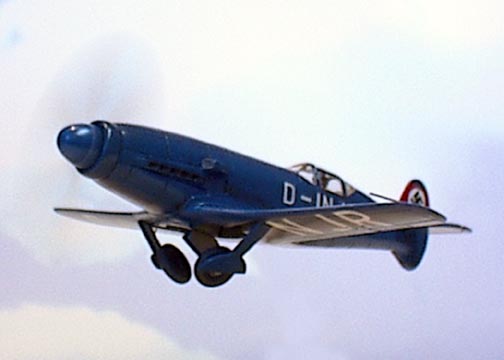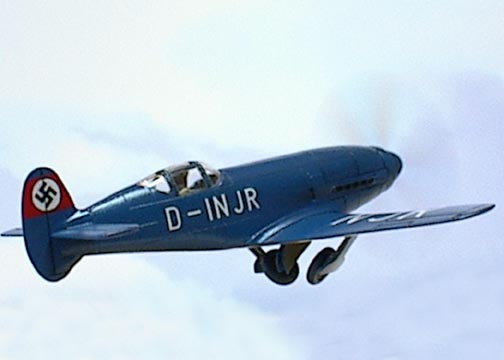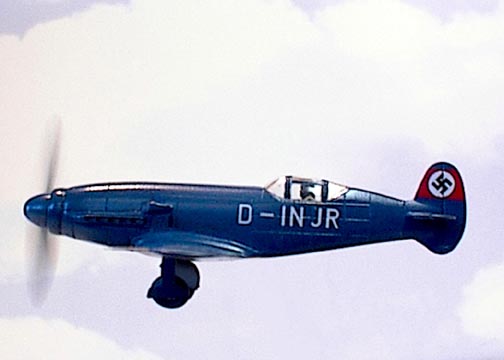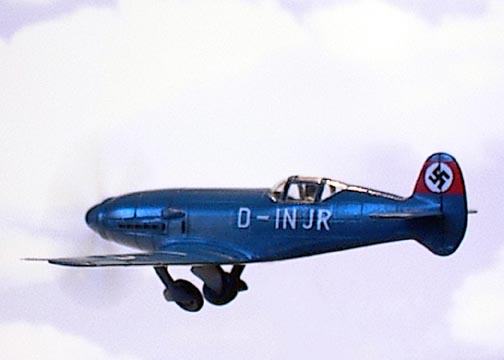
Der Blaue Streifen
Messerschmitt Me-209V1
Augsburg, Germany
April 26, 1939

Model Subject: 1/72
Messerschmitt Me-209V1
Kit used: HUMA Model, kit no. 2503

History of the aircraft modeled:
During the mid to late 1930's in Europe, there was a heated battle among the nations to set and hold the world's speed record. No one placed more emphasis on this than Adolph Hitler and both Heinkel and Messerschmitt were assigned the duty to create aircraft that would firmly establish the world's speed record for good. The Heinkel project was the He-100 and on March 30, 1939, Hans Dieterle set the record at 463.92 mph (746.6 km/h).
The second speed project was Messerschmitt's Me-209V1, which only superficially resembled a Bf-109. The aircraft was powered by a special Daimler-Benz DB 601ARJ engine with a take-off rating of 1,800 hp, which could be boosted to 2,300 hp for very short periods. This combination proved sufficient for Flugkapitän Fritz Wendel to power the prototype to 469.22 mph (755.136 km/h) on April 26, 1939. This record for propeller powered aircraft would stand for a little over thirty years, until bested by Daryll Greenamyer in a specially built "Bearcat" named "Rare Bear" on September 21, 1969 at 483.041 mph (783.20 km/h). Only one prototype was built and it was immediately sent to the German Aircraft Museum in Berlin. Like the first jet-powered aircraft, Heinkel's He-178, it was destroyed by Allied bombing raids in 1943.
Building the model:

Interior:
There's nothing fancy here. I added parachute and shoulder harnesses from sanded masking tape with a couple of True Details buckles and a couple of True Details German rudder pedals, but that's it. The kit includes an instrument panel/front bulkhead, control stick, seat, and pilot figure.
The cockpit was painted RLM02 and a few boxes and trim wheels done with sheet styrene. Instument gauges were done with Waldron punched disks of white trim film and Reheat Models Instrument gauges. I used a few Reheat Models Control and Data Placard decals on the cockpit sidewalls, instrument panel, and gear struts.
Exterior assembly, Painting, and Decaling:

Piece of cake, the fit is almost perfect! I masked the canopy with Bare-metal foil and primed the entire model in RLM02. After masking the wheel bays, I then gave the model three coats of Polly Scale RLM24 Blue, which was glossed with Polly Scale clear gloss. I scratch built the (already) retracted tailskid from sheet plastic to replace the undersized kit piece/
Main wheels were painted tire black with the centers painted RLM66 and steel used in the brake areas. The prop was painted RLM 71 Black-Green, after priming it in RLM02. The instructions indicate that the props, wheel centers, and inside gear covers were painted RLM 24 also, but I hated the look and went with the other colors. I had to break up that stark blue!
The decals are the kit's and they were terrible, as most German model decals are. They were exceedingly thick and matte. It took a full day of coaxing and cursing to get them to lie down in the recesses and not silver. The vertical tail's red band was cut from red trim film, the white circle from white trim film, and the swastikas from an old Hasegawa sheet. Control recesses and gear bays were picked out in India ink using a .005 pen. After all dried, I painted the exhausts burnt iron and the intake shutters steel. All was given two more coats of clear gloss to seal the decals and allowed to dry for a day. I next brushed some clear flat on the exhausts and wheel bays and attached the main gear assemblies. I have always toyed with the idea of doing one of my in-flight models in a take-off mode. Well, now that I've done it, I may have to do another :>).

Article and photos © Caz Dalton, February 2001